Luxury Green Flooring
The Best Types of Luxury Green Flooring for Your Home
As environmental awareness grows, more homeowners are seeking sustainable and eco-friendly options for their living spaces. Luxury green flooring not only enhances the aesthetic appeal of your home but also reduces your environmental footprint. From renewable materials to low-impact manufacturing processes, these flooring options combine luxury with sustainability. Here’s a guide to some of the best types of luxury green flooring for your home.
1. Bamboo Flooring
Why It’s Green: Bamboo is one of the most sustainable flooring materials available. Unlike traditional hardwoods, bamboo is a grass that grows quickly—some species can reach maturity in just three to five years. It regenerates without the need for replanting, making it an incredibly renewable resource.
Luxury Appeal: Bamboo flooring offers a sleek, modern look with a natural warmth. Available in a variety of finishes and grain patterns, it can mimic the appearance of more traditional hardwoods while offering a unique aesthetic. Strand-woven bamboo, in particular, is known for its durability, making it a great option for high-traffic areas.
Considerations: While bamboo is eco-friendly, it’s important to choose a product that has been harvested and manufactured responsibly. Look for certifications like FSC (Forest Stewardship Council) to ensure the bamboo was sourced sustainably.
2. Cork Flooring
Why It’s Green: Cork flooring is made from the bark of the cork oak tree, which regenerates after harvesting, allowing the tree to continue growing. The harvesting process is environmentally friendly, and the material itself is biodegradable and recyclable.
Luxury Appeal: Cork flooring offers a soft, cushioned feel underfoot, making it a comfortable choice for areas like kitchens or playrooms. It has a natural, textured appearance that adds warmth and character to any room. Cork is also an excellent insulator, helping to reduce energy costs.
Considerations: While cork is naturally resistant to mold, mildew, and termites, it can be prone to scratches and dents. A high-quality sealant can protect the surface and extend the life of the flooring.
3. Reclaimed Wood Flooring
Why It’s Green: Reclaimed wood is sourced from old buildings, barns, and other structures that have been deconstructed. By repurposing existing wood, you reduce the demand for new timber and help to minimize deforestation. This process also preserves the character and history of the wood, making it a truly unique flooring option.
Luxury Appeal: Reclaimed wood flooring brings a sense of history and authenticity to your home. The natural imperfections, weathering, and patina of the wood add depth and richness that can’t be replicated by new materials. It’s an excellent choice for homeowners looking for a rustic or vintage aesthetic.
Considerations: Reclaimed wood can be more expensive than new wood due to the labor-intensive process of sourcing, processing, and finishing the material. However, the unique beauty and environmental benefits make it a worthwhile investment for those seeking a luxury green option.
4. Linoleum Flooring
Why It’s Green: Unlike vinyl, which is made from synthetic materials, linoleum is composed of natural ingredients such as linseed oil, wood flour, cork dust, and natural pigments. It is biodegradable, non-toxic, and made from renewable resources, making it a truly green flooring option.
Luxury Appeal: Modern linoleum comes in a wide range of colors and patterns, including options that mimic the look of stone or tile. It’s durable, water-resistant, and has a long lifespan, making it suitable for high-traffic areas like kitchens and bathrooms. Its resilience and low-maintenance nature add to its luxury appeal.
Considerations: Linoleum flooring can develop a patina over time, which adds to its charm but may not appeal to everyone. It’s also important to ensure proper installation and maintenance to prevent moisture-related issues.
5. Natural Stone Flooring
Why It’s Green: Natural stone, such as marble, granite, limestone, or slate, is a long-lasting and sustainable material. When sourced locally and ethically, stone flooring has a low environmental impact, as it requires minimal processing and can last for decades or even centuries.
Luxury Appeal: Natural stone flooring is synonymous with luxury and elegance. Each stone has its own unique patterns and colors, making your floor one-of-a-kind. Stone is also incredibly durable and can add significant value to your home. It’s particularly well-suited for areas like entryways, bathrooms, and kitchens, where it makes a bold statement.
Considerations: Stone flooring can be cold and hard underfoot, so consider installing underfloor heating for added comfort. Additionally, stone can be slippery when wet, so choosing a finish with some texture or using rugs can mitigate this.
6. Wool Carpet
Why It’s Green: Wool is a natural, renewable resource that’s biodegradable and sustainable. Sheep are shorn annually, and their wool is used to create durable, high-quality carpets. Wool carpets are free from synthetic chemicals, making them a healthier option for your home.
Luxury Appeal: Wool carpets offer a plush, luxurious feel underfoot, making them a popular choice for bedrooms and living areas. They are available in a wide range of colors and patterns, and their natural resilience makes them long-lasting. Wool also has excellent insulating properties, helping to keep your home warm and reducing energy costs.
Considerations: Wool carpets can be more expensive than synthetic alternatives, but their durability and comfort often justify the higher price. They also require regular maintenance to prevent staining and moth damage.
Conclusion
Choosing luxury green flooring for your home is a smart way to combine style with sustainability. Whether you prefer the modern elegance of bamboo, the rustic charm of reclaimed wood, or the timeless beauty of natural stone, there are eco-friendly options to suit every taste and lifestyle. By selecting materials that are renewable, recyclable, or responsibly sourced, you can create a beautiful living space that reflects your commitment to the environment.



